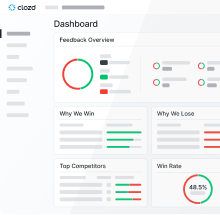
TL;DR (for busy PMMs): Win‑loss turns buyer reality into a repeatable input for positioning, enablement, roadmap, and retention. CRM “loss reasons” are often wrong; direct buyer interviews fix the signal so you can ship messaging that lands, prioritize work that moves win rate, and prove impact to revenue and NRR.
What is win‑loss analysis (and why PMMs should own it)
Win‑loss analysis is structured research with recent won and lost buyers to uncover the real decision drivers—so you can tune positioning, pricing, enablement, and roadmap. Think of it as a continuous “post‑decision interview” loop that explains why outcomes happen, not just what happened. (See Pragmatic Institute’s definition and framework for fundamentals.)
Why PMMs? Because positioning and go‑to‑market live or die on how buyers evaluate choices, not on internal hunches. Win‑loss makes PMMs the stewards of buyer truth, aligning product, marketing, and sales around verified insights.
The inconvenient truth: CRM reasons lie (a lot)
- In side‑by‑side comparisons of buyer‑reported reasons vs CRM entries, alignment is only ~15%—meaning ~85% of closed‑lost reasons in CRM are inaccurate or incomplete. Competitor tagging misses the mark ~65% of the time. That’s why teams chase the wrong fixes. (See CRM Data vs Buyer Feedback)
- Beyond mislabeled CRM dropdowns, many “losses” never go to a competitor at all. Large‑scale research on 2.5M+ sales conversations found 40–60% of deals die in no decision because buyers fear making the wrong call. That shows why seller notes often say “price” or “competitor,” while the real blocker is risk and indecision—exactly the stuff win‑loss interviews surface. Add in the fact that B2B buying teams frequently experience unhealthy conflict, and you’ve got a recipe for stalled deals that CRM can’t diagnose. Win‑loss turns those murky endings into actionable reasons you can message against. (See Harvard Business, Gartner)
So what? If your inputs are noisy, your positioning, enablement, and roadmap will drift. Win‑loss replaces assumption with evidence.
Step‑by‑step: Run a win‑loss program that actually works
- Select deals
- Target 30–60 won and lost deals from the last 2–8 weeks. Stratify by segment/ACV to avoid mixing apples and durians. (Pragmatic’s “7 steps” is a good guardrail.)
- Recruit buyers (third‑party helps)
- Outreach within 2–6 weeks of decision; offer a modest honorarium. Third‑party interviewers reduce social desirability bias and raise candor. (See Pragmatic's how to implement a win-loss program)
- Interview with a semi‑structured script
- 30 minutes to capture: decision drivers, alternatives evaluated, pricing dynamics, messaging resonance, product gaps, risk blockers, and what would’ve changed the outcome. (Pragmatic’s best‑practices checklist is handy.)
- Code + quantify
- Tag quotes, cluster themes, and quantify frequency by segment. Compare against pipeline metrics (win rate, sales cycle, discounting).
- Translate to actions
- Turn “reasons we win/lose” into:
- Positioning claims + proof points
- Objection counters + talk tracks
- Roadmap epics (with buyer quotes attached)
- Operationalize
- Ship a monthly Voice of the Buyer brief with owners and due dates; publish updates to battlecards and website copy; close the loop on what changed.
- Measure impact
- Track win rate, cycle length, renewal/NRR, and content usage → outcome correlations. According to the latest State of Win‑Loss, 63% of companies report win‑rate increases from win‑loss; 84% for programs running >2 years. (See Clozd's 2025 State of Win-Loss Analysis Report)
From insight to outcomes (the PMM leverage points)
1) Positioning & messaging (buyer‑validated)
Anchor claims to what target buyers actually value; drop internal jargon in favor of exact buyer phrasing. Pragmatic’s positioning guidance and April Dunford’s approach are both excellent scaffolds here.
Quick wins
- Replace “category‑speak” with buyer language surfaced in interviews.
- Map reason‑we‑win → differentiator & proof; reason‑we‑lose → counter‑positioning or qualify‑out.
2) Sales enablement (objections → talk tracks)
Turn the most frequent decision drivers and objections into concise talk tracks and proof content. Refresh battlecards quarterly based on new interview patterns and field feedback; Chili Piper’s enablement posts show practical mechanics.
3) Product‑market fit signals (beyond NPS)
Use win‑loss alongside PMF signals. The Sean Ellis 40% rule (≥40% “very disappointed” if your product disappeared) is a useful lead indicator—pair it with retention, expansion, and qualitative “why.”
4) Roadmap & pricing (evidence‑based)
Feed buyer‑validated gaps and willingness‑to‑pay cues to product and pricing. Dan Olsen’s PMF pyramid gives a clean model to separate problem‑solution fit from messaging fit as you iterate.
Proof it moves the numbers
- Alignment pays: Firms with high alignment across customer‑facing functions report 2.4× higher revenue growth and 2× higher profitability than those without. Win‑loss is a pragmatic way to create that alignment around buyer reality. (Per Forrester)
- Program outcomes: A majority of teams see win‑rate increases once win‑loss is institutionalized; long‑running programs report higher success rates. Clozd
- Case snapshot: Clearbit attributes a 10% increase in gross retention to its win‑loss program, which they oriented around product adoption and roadmap decisions. (Clearbit Case Study)
Metrics that matter (and how to talk about them)
- Win rate: wins ÷ (wins + losses). Example: 40 wins out of 100 closed deals = 40% win rate. Track by segment and stage.
- Sales cycle: days from qualified to closed; watch for reductions after enablement/messaging changes.
- Renewal/NRR: look for interview‑identified friction to decline over time; correlate content/feature fixes to at‑risk cohorts.
- Competitive accuracy: track % of deals with buyer‑confirmed competitor to reduce the 65% mis‑tagging problem. (See Your CRM is Lying)
(Avoid universal “good win rate = X%” claims. Benchmarks vary wildly—define your baseline, then measure deltas.)
Your first 30 days (operational checklist)
- Week 1: pick cohorts, draft invite + incentive, finalize script, stand up tagging schema.
- Week 2–3: run interviews (aim 15–25 per segment), code quotes, produce first evidence pack (5–7 insights with buyer quotes + recommended actions).
- Week 4: publish “Voice of the Buyer” brief; implement 2–3 low‑lift changes (e.g., headline copy, top‑3 objection counters); set up monthly review cadence.
Win Loss FAQs
What is win‑loss analysis?
Structured interviews with recent wins and losses to learn why deals tipped—so you can fix messaging, enablement, pricing, and roadmap with buyer truth.
Why should PMMs own it?
Because PMMs translate market reality into positioning and GTM. Owning win‑loss gives you the clearest “why” behind outcomes and a mandate to align product, sales, and marketing.
How many interviews are enough?
Directionally 15–25 per segment per quarter. Mix wins and losses. Once themes stabilize, shift to monitoring cadence.
When should we interview?
2–6 weeks after the decision. Earlier = fresher memory; later = higher no‑show. For old deals, run a short micro‑survey and prioritize current‑quarter opportunities.
Who should we interview on the buyer side?
Aim for 2 roles per deal: the primary decision maker and a power user or influencer. If procurement blocked it, talk to them too.
Should sales reps attend the interview?
No. You’ll get safer, more candid answers without the seller present. Reps can add context before/after and help validate themes once findings are ready.
Do we need incentives?
For most B2B segments, a small honorarium (e.g., gift card or donation) increases show‑rate. Executives often prefer a donation to a charity of their choice.
How do we boost participation?
Short invite, specific purpose, neutral interviewer, 30‑minute cap, flexible scheduling, and a one‑click calendar link. Follow up 2–3 times max.
What do we ask?
Keep it semi‑structured: problem context → evaluation set → decision drivers → pricing → messaging resonance → perceived risk → what would have changed the outcome.
How do we code and quantify themes?
Create a lightweight taxonomy (drivers, blockers, competitors, proof points). Tag every quote. Roll up counts by segment and ACV. Weight results if sample skews.
What should we measure after we act on insights?
- Win rate (by segment/stage)
- Sales cycle length
- Competitive accuracy (buyer‑confirmed competitor vs. CRM tag)
- Renewal/NRR changes in the affected cohort
- Content usage → outcome (did the new talk track move the stage‑win?)
Common pitfalls to avoid?
Leading questions, mixing segments, letting sellers attend, treating CRM codes as gospel, and publishing insights with no owners or due dates.
How does this tie to product‑market fit (PMF)?
Use win‑loss for the qualitative why and pair it with PMF signals (e.g., “very disappointed” survey, retention/NRR). Together they tell you if you’re winning the right customers for the right reasons.
Is “no decision” a loss or a learning opportunity?
Both. Treat “no decision” separately—fear and perceived risk often dominate. Capture what would have unblocked the deal and update your objection handling and proof.
What belongs in the monthly “Voice of the Buyer” brief?
Top 5 drivers/ blockers with quotes, recommended actions, owners, due dates, and the metric you expect to move. Keep it to one page plus appendix.











.svg)










.svg)

.svg)




